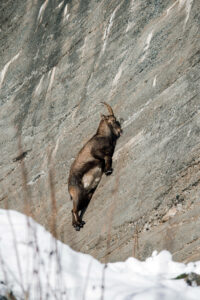There are several species of wild goats of the genus Capra living in Israel and in the mountainous regions of Europe, Southwest Asia, and Northeast Africa (French “bouquetin”; Italian “stambecco”; and Alpine “steinbock”). The ibex is translated as “mountain goats” in the Bible, but it is not to be confused with the North American and Alaskan wild variety which is in a different genus Oreamnos.
The name ibex (Hebrew “Yael,” meaning literally, “to ascend”) aptly describes its agility in climbing mountain terrain. It is mentioned at least four times in the Old Testament. In Job 39:1, God asks, “Do you know the time the mountain goats give birth?” The literal Hebrew is “goats of the rock” and is a reference to the ibex. In I Samuel 24:2, Saul pursued David to the cliffs at Ein Gedi overlooking the Dead Sea, “near the Crags of the Wild Goats” [Ibex]. Since the ibex was permitted for food in the Jewish dietary law (Deuteronomy 14:5), they were hunted to near extinction by the early twentieth century. As a result of conservation measures, its population has again “ascended,” and ibex again roam the Negev and Judean deserts by the thousands.
Male ibexes are easily identified by their large, semicircular, knotty horns and black beards. They are larger than domesticated goats, often weighing 250-300 pounds. These majestic creatures appear in many artistic representations. Proverbs 5:19 identifies “a graceful doe” (Hebrew “yaalah” = Ibex) as a metaphor for the desirability of a youthful wife. Ancient Egyptians considered the ibex a good luck charm and symbol of renewal. In biblical times their skin was used to make parchment for writing.
Source: “Ibex,” Biblical Archaeology Review, Summer 2023, p. 68.





